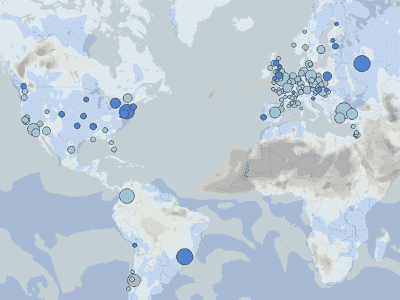This online tool lets you check your city’s air quality in real time

 Paris-based Plume Labs launched their interactive global pollution map earlier this year, and then followed it up co-organizing a presentation at the COP21 U.N. climate summit called “Data Against Climate Change”.
Paris-based Plume Labs launched their interactive global pollution map earlier this year, and then followed it up co-organizing a presentation at the COP21 U.N. climate summit called “Data Against Climate Change”.
Plume Labs sources its data from a diverse range, collecting half a million open data measurements from 11,000 stations each day to build predictive air quality models for more than 200 cities in 40 countries, and then maps the result on an hourly basis in its app, available on Apple’s App Store and Google Play.
A little surprisingly, Vancouver at this moment has crested above its normal average rating with air quality rated at “low pollution” levels, while Montreal has dipped below its normal levels to qualify for “fresh air” status.
Things get a little more worrying, though, when you look at cities like New Delhi, Nanjing, both rated at “extreme pollution”, or Lima, rated “high pollution”.
Meanwhile, Paris, Phoenix and Warsaw all rate at a more reassuring “low pollution” level.
The site uses the ratings system to offer practical advice, such as “go for it” under “low pollution” levels in New York when it comes to outdoor exercise, eating outside or bringing the baby for a walk.
Aside from providing air quality data as a lifestyle accompaniment, though, Plume Labs hopes that eventually data can help to improve emergency response systems, and that data from mobile devices will detect stress signals during natural disasters.
One recent study suggests that particle pollutants killed 3.15-million people in 2010, mostly through strokes and heart attacks.
Co-founders Romain Lacombe and David Lissmyr started the company on the premise that “Information is the answer to fight off pollution.”
Robert Kirkpatrick, who works for UN Global Pulse in the Executive Office of the UN Secretary General, was invited by Plume Labs to participate in their COP21 panel.
Kirkpatrick said “a country not willing to implement data analysis programs won’t be able to tackle sustainable development issues.”
The “Data Against Climate Change” panel emphasized the need for climate data to be open source, allowing governments and individuals full access to use the information in the most effective way possible.
With a team of 14 employees, they’re developing a Plume sensor prototype that will allow individuals to contribute to Plume’s worldwide air quality map.
One recent study suggests that particle pollutants killed 3.15-million people in 2010, mostly through strokes and heart attacks. In China, which is unsurprisingly one of the places in the world with the dirtiest air, ir pollution is a leading cause of death, killing more people that road transport or HIV/AIDS.
Surprisingly, air quality in Bejing is improving, according to new data from the U.S. State Department. But the city still has a ways to go: just 21 per cent of the city’s days met the U.S. standard for healthy air, measured at or below 35.4 micrograms per cubic meter for a 24-hour period.
Bejing’s worst day of 2014 was really bad. 449.8 micrograms per cubic metre was measured on February 25th, a level that only earned the country’s second highest pollution designation, an “orange alert”.

Terry Dawes
Writer
